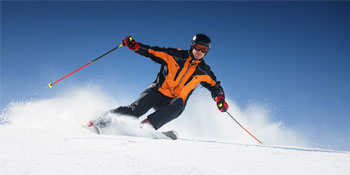
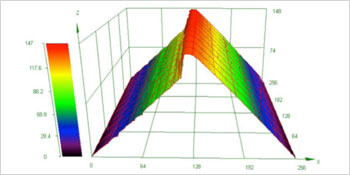
Executive Summary
Within any sport, the fine-tuning of equipment can play a significant role in the outcome of competition. In the world of skiing and snowboarding, the sharpness of one's skis or board can drastically affect performance. At the highest levels of competition, the precision of edge sharpening becomes even more critical as the difference between finish times becomes smaller and smaller and every variable is increasingly magnified. To create a new level of sharpening accuracy, and measure ski edge resistance to a variety of surfaces and conditions, the Worcester Polytechnic Institute Sports Engineering Lab has designed and prototyped a device capable of extremely precise 3D ski edge imaging and measurement.
The objectives of this device are to measure the sharpness of ski and snowboard edges in two fundamental ways: functional and geometric, advancing the understanding of how the geometry of the edge relates to its performance. These measures can then be used to evaluate edges and preparation methods, making them especially important for competition as well as ski manufacturing and general ski maintenance.
Methodology
The current methods of assessing the sharpness of ski edges are qualitative and subjective, relying on tactical sensation. With this new device, sharpness is determined in the lab by applying a predetermined load to material like ice or a snow simulation material, oriented at fixed angle to the edge, then measuring the load necessary to cause movement perpendicular and parallel to the edge (Fig. 1). The geometry is measured and the curvature is calculated as functions of scale and position over the edge. Correlations are determined by linear regression analyses of performance versus curvature as a function of scale. Ski edges are measured with a laser scanning confocal microscope (OLYMPUS LEXT OLS4100). Curvatures are calculated using Heron's method (Gleason at al. 2013)1.
Basic Principle of Performance Measurements
Created to provide equipment manufacturers, skiing facilities, athletes, and coaches with the means to measure ski and snowboard edges with a new level of accuracy, the ski edge measuring device developed by the WPI Sports Engineering Lab allows users to measure resistance to skidding perpendicular to an edge as well as sliding along an edge. Through the use of the LEXT OLS4100, this device can be used to create 3D topographic ski edge measurements specifically direct measurement and characterization of edge curvature.
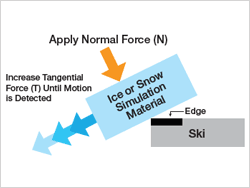 Figure 1: Basic principle of device performance measurements. |
Ratio of tangential to normal force T/N
|
The Importance of Proper Edge Roughness
The sharpness of a ski or snowboard edge plays a critical role in its performance. If an edge is too dull, it can cause control issues in both racing and recreational skiing. If icy hard-surface conditions are present, which occur occasionally in parts of the Northeast United States, control issues are even further magnified by dull edges. In the world of competitive racing, edges are sharpened even further to provide the ability to cut at high speeds with skis positioned at a sharp angle. Of additional consideration is the fact that highly sharpened edges can cause injury and should be treated with proper care and consideration both in use and while being handled.
Skiing Relative to Machining
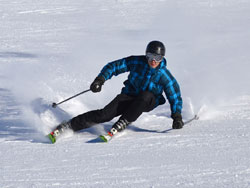 Figure 2: Skidding, made possible by highly sharpened ski edges | When considering ski edge roughness and its relation to skiing performance, ski snow forces can be compared to machining. Skidding (cutting through snow with skis at an extremely high angle [Fig. 2]) is analogous to cutting, with the ski itself representing the tool and the snow representing the work piece. Turning force on the skis equals cutting force on the tool, and the edge angle of the ski (more than 90° when skidding) is comparable to the rake angle of the tool. The sharpness of the skis, similar to the sharpness of a tool, is the limiting factor that determines how much edge (rake) angle the skis can withstand while skidding/ carving (cutting) through snow. |
Ski Edge Curvature
In the development of their new ski edge imaging and measuring device, the measurement specialists at WPI Sports Engineering Lab, led by Dr. Christopher Brown, set out to create a new way of looking at ski edge curvature, which provides an extremely precise means of viewing and analyzing ski edge roughness. By combining a physical assembly (Fig. 3) designed to provide optimal ski edge viewing with a laser scanning confocal microscope system (Olympus LEXT OLS4100 [Fig.4]),Dr. Brown and his team have pioneered a new way to measure ski edge sharpness by accurately characterizing ski edge curvature.
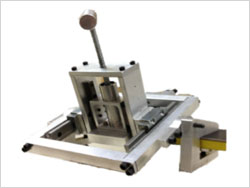 Figure 3: Assembly prototype at WPI manufacturing labs. Edge sharpness configuration tests resistance perpendicular to ski edge. Load frame can be rotated to test resistance parallel to ski edge. | 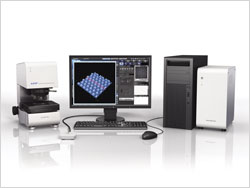 Figure 4: OLYMPUS LEXT OLS4100 laser scanning confocal microscope. |
Roughness Imaging & Analysis
This new ski edge measurement system presents users with the means to create and analyze 3D topographic images of ski edge curvature. To showcase the effectiveness of this system, the WPI Sports Engineering Lab created and analyzed the following images of ski edges created with a variety of sharpening techniques. Terminology is based on a standard ski edge (Fig. 5).
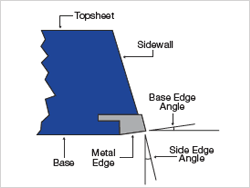 Figure 5: This diagram represents the basic layout of and terminology associated with a standard ski edge | 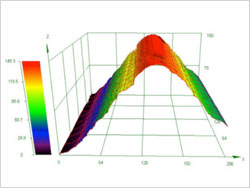 Figure 6: Profile of ski edge with no modifications. |
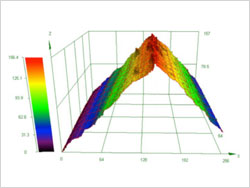 | The same ski edge after sharpening with a file. Sharpening was done in an alternating fashion (switching between base edge and side edge) to allow for the comparison of surface roughness between different sharpening instruments. |
 | The same ski edge after additional sharpening with a coarse diamond stone. It can be seen that after this sharpening, the bur at the tip of the edge changed direction, due to the alternating method used in sharpening the ski. |
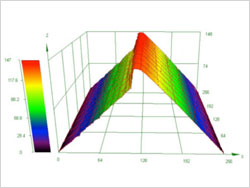 | Professional skiers do not typically sharpen their skis in the previously seen alternating manner. Instead, they fully sharpen the base edge and then fully sharpen the side edge. This directs the bur in a direction parallel with the ski edge as opposed to parallel with the base edge. The image above depicts a ski edge that has been sharpened with only a file using the standard method— there are clear inconsistencies on the surface of the ski edge as well as a jagged bur directly on the edge. |
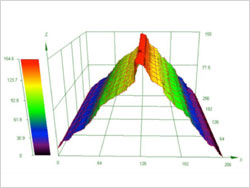 | The ski edge from previously seen after an additional standard-method sharpening with a ceramic stone. This additional process renders the surface much smoother and also produces a less jagged bur. |
Conclusion
Based on these 3D topographic images, Dr. Brown and his team were able to solidify the following conclusions regarding the ski edge sharpening techniques highlighted here:
- The method of sharpening (alternating vs. standard) will determine the direction of the bur at the tip of the ski edge.
- This bur can be beneficial to a skier by providing traction on turns; however, it can be disadvantageous by creating friction on straight paths, thus slowing the skier down.
- A ski sharpened with just a file is smoother than an unsharpened ski.
- A ski sharpened with a stone is even smoother than a ski sharpened with a ile.
- A progression system of sharpening starting with a standard ile and moving down toward a specialized sharpening stone will greatly decrease the surface roughness of the ski edge and provide a smoother ride to the skier.
Summary
The level of curvature imaging and edge measurement allowed by this new device is made possible by the implementation of direct geometric 3D confocal microscopy, which allows the calculation of curvature versus position and scale, a new calculation method used exclusively by this patent-pending system. In the past, curvature characterization had been problematic, as curvature varies with scale and position. Through their work with this new ski edge measurement system, WPI Sports Engineering Lab is pioneering multi-scale position-specific curvature characterization. This new system has been designed and prototyped to measure ski edge resistance to both skidding perpendicular to an edge and sliding along an edge. A provisional patent has been filed.
1Gleason, M. A., Kordell, S., Lemoine, A., Brown, C. A. (2013) Profile curvatures by Heron’s formula as a function of scale and position on an edge rounded by mass finishing. 14th International Conference on Metrology and Properties of Engineering Surfaces, Taiwan 17-21 June 2013.

